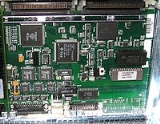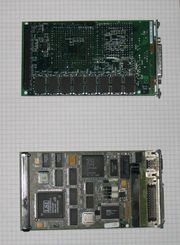
SBus
Encyclopedia


Computer bus
In computer architecture, a bus is a subsystem that transfers data between components inside a computer, or between computers.Early computer buses were literally parallel electrical wires with multiple connections, but the term is now used for any physical arrangement that provides the same...
system that was used in most SPARC
SPARC
SPARC is a RISC instruction set architecture developed by Sun Microsystems and introduced in mid-1987....
-based computers (including all SPARCstation
SPARCstation
The SPARCstation, SPARCserver and SPARCcenter product lines were a series of SPARC-based computer workstations and servers in desktop, deskside and rack-based form factor developed and sold by Sun Microsystems...
s) from Sun Microsystems
Sun Microsystems
Sun Microsystems, Inc. was a company that sold :computers, computer components, :computer software, and :information technology services. Sun was founded on February 24, 1982...
and others during the 1990s. It was introduced by Sun in 1989 to be a high-speed bus counterpart to their high-speed SPARC processors, replacing the earlier (and by this time, outdated) VMEbus
VMEbus
VMEbus is a computer bus standard, originally developed for the Motorola 68000 line of CPUs, but later widely used for many applications and standardized by the IEC as ANSI/IEEE 1014-1987. It is physically based on Eurocard sizes, mechanicals and connectors , but uses its own signalling system,...
used in their Motorola
Motorola
Motorola, Inc. was an American multinational telecommunications company based in Schaumburg, Illinois, which was eventually divided into two independent public companies, Motorola Mobility and Motorola Solutions on January 4, 2011, after losing $4.3 billion from 2007 to 2009...
68020- and 68030-based systems and early SPARC boxes. When Sun moved to open the SPARC definition in the early 1990s, SBus was likewise standardized and became IEEE-1496. In 1997 Sun started to migrate away from SBus to the Peripheral Component Interconnect
Peripheral Component Interconnect
Conventional PCI is a computer bus for attaching hardware devices in a computer...
(PCI) bus, and today SBus is no longer used.
The industry's first 3rd party SBus cards were announced in 1989 by Antares Microsystems. These were: a 10Base-2 Ethernet Controller, a SCSI-SNS Host Adapter, a Parallel Port, and an 8-Channel Serial Controller.
The specification was published by Edward H. Frank and James D. Lyle.
A technical guide to the bus was published in 1992 in book form by Lyle, who founded Troubador Technologies. Sun also published a set of books as a "developer's kit" to encourage third-party products.
At the peak of the market over 250 manufacturers were listed in the SBus Product Directory, which was renamed to the SPARC Product Directory in 1996.
SBus is in many ways a "clean" design. It was targeted only to be used with SPARC processors, so most cross-platform issues were not a consideration. SBus is based on a big-endian 32-bit
32-bit
The range of integer values that can be stored in 32 bits is 0 through 4,294,967,295. Hence, a processor with 32-bit memory addresses can directly access 4 GB of byte-addressable memory....
address and data bus, can run at speeds ranging from 16.67 MHz to 25 MHz, and is capable of transferring up to 100 MB/s. Devices are each mapped onto a 28-bit address space (256 MB). Only eight masters are supported, although there can be an unlimited number of slaves.
When the 64-bit
64-bit
64-bit is a word size that defines certain classes of computer architecture, buses, memory and CPUs, and by extension the software that runs on them. 64-bit CPUs have existed in supercomputers since the 1970s and in RISC-based workstations and servers since the early 1990s...
UltraSPARC was introduced, SBus was modified to use clock doubling and transfer two 32-bit data words per cycle to produce a 200 MB/s 64-bit bus. This variant of the SBus architecture used the same 96-pin connector as the older one.
SBus cards had a very compact form factor for the time. A single-width card was 3 inches (7.6 cm) wide by 5 inches (12.7 cm) long and is designed to be mounted parallel to the motherboard. This allowed for three expansion slots in the slim "pizza box
Pizza box form factor
In computing, a pizza box is a style of case for computers or network switches. Cases of this type tend to be wide and flat, normally one or two rack units in height, thus resembling pizza delivery boxes....
" enclosure of the SPARCstation 1
SPARCstation 1
The SPARCstation 1, or Sun 4/60, is the first of the SPARCstation series of SPARC-based computer workstations sold by Sun Microsystems. It had a distinctive slim enclosure and was first sold in April 1989, with Sun's support for it ending in 1995.Based around a LSI Logic RISC CPU running at...
. The design also allows for double- or triple-width cards that take up two or three slots, as well as double-height (two 3x5 inch boards mounted in a "sandwich" configuration) cards.
SBus was originally announced as both a system bus
System bus
A system bus is a single computer bus that connects the major components of a computer system. The technique was developed to reduce costs and improve modularity....
and a peripheral interconnect that allowed input and output devices relatively low latency access to memory. However, soon memory and Central processing unit
Central processing unit
The central processing unit is the portion of a computer system that carries out the instructions of a computer program, to perform the basic arithmetical, logical, and input/output operations of the system. The CPU plays a role somewhat analogous to the brain in the computer. The term has been in...
(CPU) speeds outpaced I/O performance.
Within a year some Sun systems used MBus, another interconnection standard, as a CPU-memory bus.
The SBus served as an input/output bus for the rest of its lifetime.

